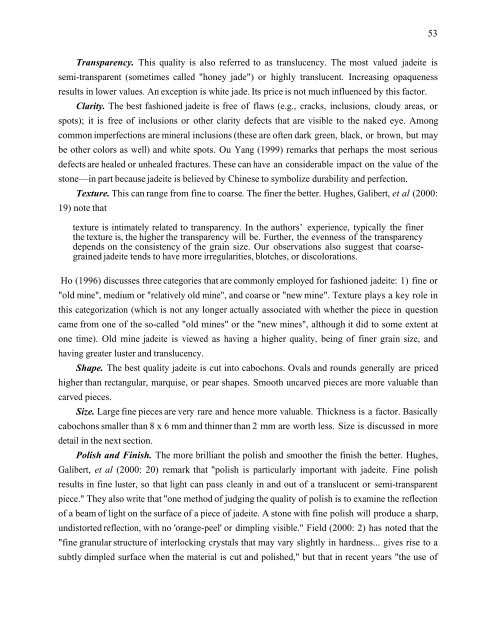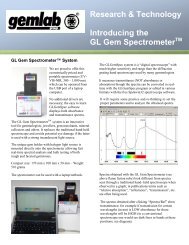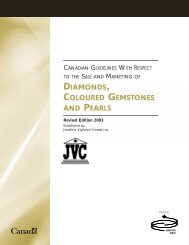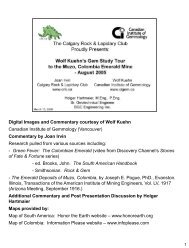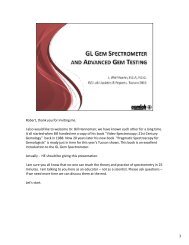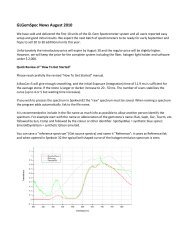JADEITE - Canadian Institute of Gemmology
JADEITE - Canadian Institute of Gemmology
JADEITE - Canadian Institute of Gemmology
Create successful ePaper yourself
Turn your PDF publications into a flip-book with our unique Google optimized e-Paper software.
Transparency. This quality is also referred to as translucency. The most valued jadeite is<br />
semi-transparent (sometimes called "honey jade") or highly translucent. Increasing opaqueness<br />
results in lower values. An exception is white jade. Its price is not much influenced by this factor.<br />
Clarity. The best fashioned jadeite is free <strong>of</strong> flaws (e.g., cracks, inclusions, cloudy areas, or<br />
spots); it is free <strong>of</strong> inclusions or other clarity defects that are visible to the naked eye. Among<br />
common imperfections are mineral inclusions (these are <strong>of</strong>ten dark green, black, or brown, but may<br />
be other colors as well) and white spots. Ou Yang (1999) remarks that perhaps the most serious<br />
defects are healed or unhealed fractures. These can have an considerable impact on the value <strong>of</strong> the<br />
stone—in part because jadeite is believed by Chinese to symbolize durability and perfection.<br />
Texture. This can range from fine to coarse. The finer the better. Hughes, Galibert, et al (2000:<br />
19) note that<br />
texture is intimately related to transparency. In the authors’ experience, typically the finer<br />
the texture is, the higher the transparency will be. Further, the evenness <strong>of</strong> the transparency<br />
depends on the consistency <strong>of</strong> the grain size. Our observations also suggest that coarsegrained<br />
jadeite tends to have more irregularities, blotches, or discolorations.<br />
Ho (1996) discusses three categories that are commonly employed for fashioned jadeite: 1) fine or<br />
"old mine", medium or "relatively old mine", and coarse or "new mine". Texture plays a key role in<br />
this categorization (which is not any longer actually associated with whether the piece in question<br />
came from one <strong>of</strong> the so-called "old mines" or the "new mines", although it did to some extent at<br />
one time). Old mine jadeite is viewed as having a higher quality, being <strong>of</strong> finer grain size, and<br />
having greater luster and translucency.<br />
Shape. The best quality jadeite is cut into cabochons. Ovals and rounds generally are priced<br />
higher than rectangular, marquise, or pear shapes. Smooth uncarved pieces are more valuable than<br />
carved pieces.<br />
Size. Large fine pieces are very rare and hence more valuable. Thickness is a factor. Basically<br />
cabochons smaller than 8 x 6 mm and thinner than 2 mm are worth less. Size is discussed in more<br />
detail in the next section.<br />
Polish and Finish. The more brilliant the polish and smoother the finish the better. Hughes,<br />
Galibert, et al (2000: 20) remark that "polish is particularly important with jadeite. Fine polish<br />
results in fine luster, so that light can pass cleanly in and out <strong>of</strong> a translucent or semi-transparent<br />
piece." They also write that "one method <strong>of</strong> judging the quality <strong>of</strong> polish is to examine the reflection<br />
<strong>of</strong> a beam <strong>of</strong> light on the surface <strong>of</strong> a piece <strong>of</strong> jadeite. A stone with fine polish will produce a sharp,<br />
undistorted reflection, with no 'orange-peel' or dimpling visible." Field (2000: 2) has noted that the<br />
"fine granular structure <strong>of</strong> interlocking crystals that may vary slightly in hardness... gives rise to a<br />
subtly dimpled surface when the material is cut and polished," but that in recent years "the use <strong>of</strong><br />
53


